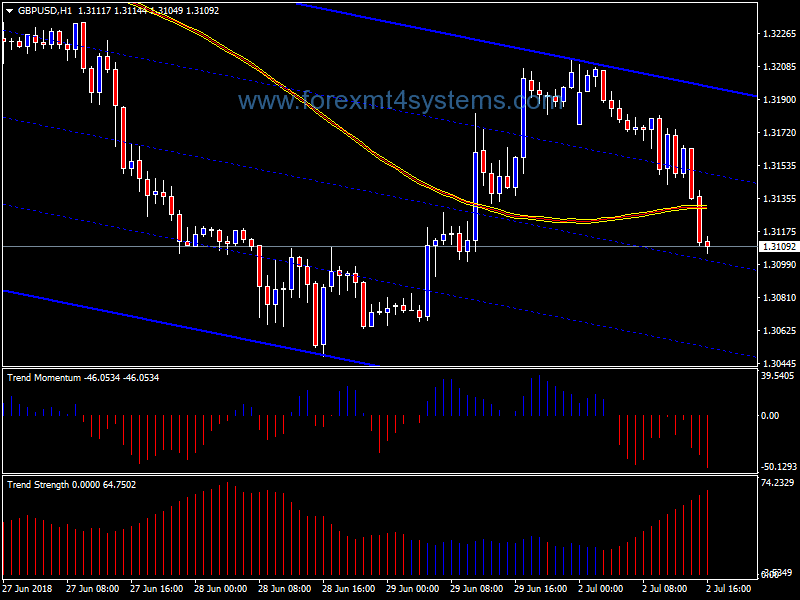Forex Trend Momentum Trading System: A Comprehensive Guide
The Forex Trend Momentum Trading System is a popular trading strategy that capitalizes on strong trends in the foreign exchange market. This system aims to identify and ride trends for as long as possible until the momentum starts fading.

Download Free Forex Trend Momentum Trading System
What is the Forex Trend Momentum Trading System?
The Forex Trend Momentum Trading System is a rules-based approach to trading that uses technical analysis and indicators to identify strong trends and momentum in the forex market. The goal is to enter trades in the direction of the trend and hold the positions open for an extended period while the trend remains intact.
Some key features of this trading system include:
- Identifying trends using indicators like moving averages and analyzing price action
- Entering trades in the direction of the trend once momentum has been confirmed
- Using trailing stops to lock in profits as the trend extends
- Strictly defining entry, exit and risk management rules
- Trading with the major trend on higher time frames
- Aiming for larger gains over longer holding periods
The Forex Trend Momentum system aims to maximize gains by capitalizing on sustained directional moves in the forex market. It uses indicators like the Relative Strength Index (RSI) and Moving Average Convergence Divergence (MACD) to gauge the strength of trends and time entries. The system also incorporates trailing stops to book profits along the way as long as the trend persists.
How Does the Forex Trend Momentum System Work?
The Forex Trend Momentum trading system is based on the principle that strong trends tend to persist and gain momentum over time. It aims to identify these high-probability trends early on and ride them for an extended period.
Here are the key steps involved in this trading approach:
1. Identify the Trend
The first step is to analyze the higher time frame charts, such as the daily or weekly charts, to identify the major trend. The system trades in the direction of the prevailing trend. Common ways to identify trends include:
- Price moving above or below a long-term moving average like the 200-day MA
- Higher highs and higher lows for uptrends, lower highs and lower lows for downtrends
- Strong directional movement signaling a trend
2. Confirm Momentum
Once the trend direction is determined, the next step is to drill down to a lower time frame chart like the hourly chart and look for confirmation of momentum in the trend. Indicators like the MACD and RSI can signal increasing momentum. Other confirmations include:
- The price breaking above a short-term MA like the 20-period MA
- The RSI breaking above 50 for uptrends or below 50 for downtrends
- The MACD signal line crossing above the MACD line
3. Enter Trades
The system enters trades in the direction of the trend once momentum has been confirmed. Entry signals include:
- Price breaking through resistance or support levels
- Reversal candlestick patterns at support/resistance
- Overbought/oversold levels reached on oscillators
- Moving average crossovers in the trend direction
Precise entry levels are defined, along with appropriate stop losses to control risk.
4. Manage Trades
Once in a trade, the Forex Trend Momentum system uses the following techniques to maximize profits:
- Trailing stop loss to lock in profits as the trend extends
- Partial profit taking at defined price targets
- Monitoring higher time frame charts to identify trend changes
- Exiting on reversal signals from indicators like RSI or MACD
Strict risk management rules are followed, with a maximum risk per trade of 2% of capital.
Benefits of the Forex Trend Momentum System
Some of the key advantages of this trading approach include:
- Captures large moves as trends persist
- Trades in the direction of momentum
- Clear entry and exit rules
- Mechanical system removes guesswork
- Risk management helps preserve capital
- Large profit potential over time
By focusing only on high probability setups and managing trades effectively, the Forex Trend Momentum system aims to maximize gains.
What Indicators Are Used?
The Forex Trend Momentum trading system uses the following key indicators:
Moving Averages
Moving averages are used to identify the trend and act as dynamic support/resistance levels. The 20 and 200-period MAs are popular choices.
Relative Strength Index (RSI)
The RSI measures the speed and magnitude of recent price movements. Overbought/oversold levels signal reversals.
Moving Average Convergence Divergence (MACD)
The MACD crossover indicates momentum in the trend direction. The histogram bars also show accelerating momentum.
Bollinger Bands
Bollinger Bands measure volatility and contain price action. Breakouts above or below the bands can signal momentum.
Average True Range (ATR)
The ATR indicator helps determine appropriate stop loss levels based on the market’s volatility.
These indicators help traders time entries, gauge momentum, identify possible reversals, and manage risk.
What Currency Pairs Work Best?
The Forex Trend Momentum system works well with all liquid major and minor currency pairs. Some good ones to trade with this system include:
- EUR/USD: Popular pair that trends well and has low spreads
- GBP/USD: Tends to trend strongly and has high volatility
- USD/JPY: Moves aggressively with risk sentiment due to carry trade
- AUD/USD: Trends smoothly with interest rate differentials
- USD/CAD: Counter-trend opportunities with oil correlation
Traders should focus on pairs that show a persistent trend rather than choppy back-and-forth price action. Checking the daily ATR can give a sense of which pairs have strong and smooth trends.
Common Trading Rules and Money Management
Successful implementation of the Forex Trend Momentum system for MetaTrader 4 requires following some common sense trading rules and money management practices:
- Trade with the major daily chart trend
- Use a maximum risk per trade of 2% of capital
- Place stop loss orders for every trade before entry
- Book partial profits at a minimum 1:2 risk-reward ratio
- Trail stop losses to lock in profits as trend continues
- Re-assess trades when they go 150-200 pips against entry
- Adhere strictly to entry, exit and stop loss rules
- Avoid overtrading by being patient for setups
- Maintain trading journal to review performance
Following these guidelines will help preserve capital, maximize gains, and improve the odds of long-term trading success.
The System in Action – Trade Examples
Here are two examples of actual trades taken based on the Forex Trend Momentum system:
Trade 1: Long EUR/USD
- Daily chart shows uptrend with rising 200-day MA
- Hourly chart shows bullish momentum with MACD crossover
- Enter long trade on break above 1.1975 resistance level
- Place initial stop loss at 1.1950 and trail it higher
- Take partial profits at 1.2050 and move stop to breakeven
- Exit 50% of position at 1.2150 with trailing stop
- Trail the remaining position and exit at 1.2230
Trade 2: Short GBP/USD
- Daily downtrend confirmed with price under 200-day MA
- Bearish momentum signaled by RSI breaking below 50
- Enter short trade at 1.3015 old support turned resistance
- Set initial stop loss at 1.3090, risking 75 pips
- As downtrend extends, trail stop lower to lock in profits
- Take partial profits at 1.2935 and 1.2860
- Exit remainder of trade when RSI breaks above 50
These examples demonstrate how the Forex Trend Momentum system capitalizes on strong directional moves in the forex markets by effectively identifying and managing profitable trends.
Forex Trend Momentum Trading System – The Bottom Line
The Forex Trend Momentum trading system offers a rules-based approach to trading trends efficiently. By combining trend analysis with momentum indicators, traders can identify high-probability trades. Defined entry rules, smart trade management techniques, and disciplined risk control help maximize profits. While no system can guarantee wins, this strategic approach can potentially deliver sizeable gains over time.


